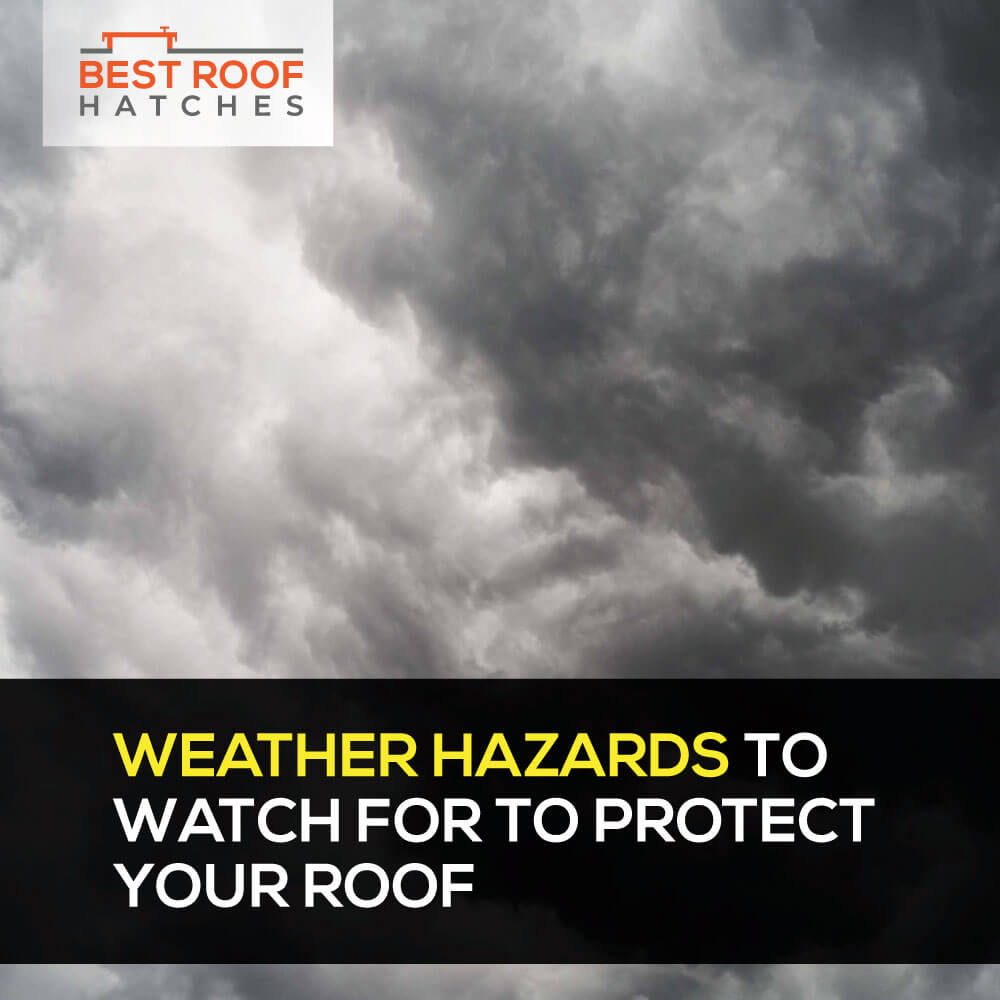Share this
Weather Hazards to Watch for to Protect Your Roof
Posted by Best Roof Hatches on 2021 Nov 17th
Nothing puts you on edge than extreme weather. Whether it’s pounding rain and striking thunder or a blizzard that can knock the power out for days, the supreme force of nature can have you questioning your roofing system’s capability to endure and overcome natural calamities.
Despite this, many people still neglect their roofs, not realizing that numerous roofing hazards can cause heavy damage. Property owners who understand the importance of their commercial space are all working on roof risk assessment to ensure steadfastness and withstand harsh weather.
Water leaks, snow, and fallen tree branches exhibit hazards that make your commercial roof susceptible to bad weather conditions. Weather can sometimes be unpredictable; it is crucial to be proactive regarding roof maintenance and inspections.
You may hire an expert to help you maintain your roof, or you can always do it yourself using roof safety equipment. If repairs are needed, ensure that you properly plan the project. Some risk assessments for roof work examples are: appropriately organize work, assess the risks from employment, appropriate work equipment, and more.
Geography also plays a crucial role in how the weather affects your roofing system and how much maintenance and work is needed. Some parts of the country are more vulnerable to scorching heat and heavy snow and ice. That said, it is critical to becoming aware of how each weather phenomenon or element can damage your roof.
Rain
When asked about the one element that causes the most damage to roofs, rain would most likely be on top of the list. Water damage, in general, serves as a gateway to other problems, such as pooling water and moisture that causes mold and mildew. Water leakage can find its way inside your property, compromising the overall durability of the whole structure. Quick observation is necessary to address the holes and the cracks immediately. If your property is in a rain-prone area, it is best to speak with a professional so that together, you may find ways to extend the life of your roof.
Heat
Your roof serves as a protective barrier for your commercial property from harmful elements outside. Think of it as a hat that protects your head from the harsh sun. Even a beautiful sunny day can prove taxing to the sturdiest roofing systems over time, as excessive heat can make certain materials swell and stretch. Prolonged sun exposure can also force some materials to crack and become brittle. You need to conduct routine checks on your roofing system and the areas often exposed to the sun. You can easily do this with convenient handy ladder access to your roof hatch.
Wind
A usual gush of wind may pose no threat to your roofing system’s durability, but in difficult situations, when it turns to a hurricane or tornado, then you have to be prepared. Strong winds combined with heavy rain can be extremely harmful to your roof. Powerful winds can move panels and roof shingles, tear off gutters, send tree branches crashing into the top, and wear down the roof materials. In areas where hurricanes and tornadoes are frequent, take extra precautions to avoid fragile roof hazards. Even if you conduct preemptive actions to keep your commercial roof sturdy, make sure to still inspect it after a heavy storm.
Snow
Dealing with snow can be a bit more complicated than water damage. It is technically water, but it melts slower, thus risking water leaks and damaged shingles if it seeps inside and refreezes. The weight of the snow and ice can quickly build up and be a problem if it exceeds your roof’s weight limitation. Winter can last for months and some even longer, so be sure to shovel the excess of your roof using a roof safety harness. Know what type of roofing material you need and remove snow build-up on your commercial top as much as possible.
Hails Storm
This weather phenomenon can be exceptionally harmful to your roof as large pieces can instantly demolish rooftops. The materials on the top only take so much damage before breaking down to the damaging hailstorm. You can’t do anything during a storm, but it is crucial to assess your roof for any damage immediately. It is advisable to have a roof work safety checklist to avoid missing improvement opportunities to prepare your roofing system for the next hail onslaught.
Tree Branches
Many people value the importance of having trees around their property. It makes the air cleaner, and it also serves as a natural shield to your roof from the harsh effects of the sun. However, trees can pose a threat to the sturdiness of your roof, depending on how tall they stand. All it takes is one big, windy storm to knock out trees or blow away branches straight to your top; thankfully, there are ways to prevent this from happening. Call a professional to cut down tree branches that are hovering over your roof. If needed, let tenants know that you’re gearing towards working on a roof regulation to cut tree branches now and then ensure their safety.
There is little we can do to prevent the intensity of mother nature, and it will constantly relentlessly challenge the credibility of your commercial roofing system. The important thing that we should do is be proactive in scheduling inspections and maintenance with the help of a professional. Heed their recommendations and be prepared when calamity strikes.
Regular assessment is necessary for taking care of your roof, and you have to have the proper knowledge and equipment to stay prepared. Here in Best Roof Hatches, we provide the finest products and great tips to help you maintain your roof. Partner with us today and visit https://bestroofhatches.com/ or call us at 1-800-431-8651.

